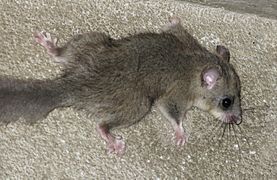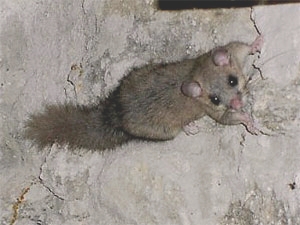Edible dormouse facts for kids
Quick facts for kids Edible dormouseTemporal range: Oligocene–Recent
|
|
|---|---|
 |
|
| Conservation status | |
| Scientific classification | |
| Kingdom: | |
| Class: | |
| Order: | |
| Family: | |
| Subfamily: | |
| Genus: |
Glis
|
| Binomial name | |
| Glis glis (Linnaeus, 1766)
|
|
The edible dormouse or 'fat dormouse' (Glis glis) is a small dormouse. It is the only species in its genus, Glis. These dormice are the largest ones found in Europe.
Long ago, the ancient Romans raised these dormice to eat them. This is why they are called "edible" dormice. They kept them in special clay pots called gliraria, much like modern hamster cages.
Today, wild edible dormice are still eaten in Slovenia. Trapping them is a long-standing tradition there. People have used dormice for food and fur since the 13th century. Their fat was even used as a medicine. Poor and hungry peasants would eat dormice in winter for a good source of protein.
The edible dormouse lives across Europe. Some were accidentally introduced to England in 1902. They escaped from the private collection of Lionel Walter Rothschild in Tring. The British population is now about 10,000. They live in a 200-square-mile (520 km2) area between Beaconsfield, Aylesbury, and Luton.
Contents
What Does an Edible Dormouse Look Like?
The edible dormouse is the biggest dormouse. Its body is about 14 to 19 cm (5.5 to 7.5 in) long. Its tail adds another 11 to 13 cm. It usually weighs 120 to 150 g (4.2 to 5.3 oz). Before hibernation, it can almost double its weight.
These dormice look a bit like squirrels. They have small ears, short legs, and large feet. Their fur is grey to brownish-grey. Their undersides and inner legs are white. They do not have dark markings on their face, except for faint rings around their eyes. Their tail is long and bushy, and a bit darker than their body.
Their front feet have four toes, and their back feet have five. The bottoms of their feet are bare. Female dormice usually have four to six pairs of teats.
Edible dormice can drop their tails if a predator grabs them. The skin breaks easily, letting the dormouse escape. The exposed bones then break off. The wound heals, and new fur grows back.
Where Do Edible Dormice Live?
Edible dormice are found in much of western Europe. They also live on several Mediterranean islands. These include Sardinia, Corsica, Sicily, and Crete. They are less common in central Europe and the Balkans. You can find them as far north-east as the upper Volga River in Russia. They also live in the Caucasus region and along the southern Caspian Sea coast.
In Germany, there are small groups of edible dormice. There are usually two to six dormice per hectare. Beyond Europe, they are found in parts of Thrace. This area is on the southeastern tip of the Balkan peninsula.
As mentioned, they were accidentally brought to Tring in England in 1902. This happened when some escaped from Lionel Walter Rothschild's collection. Now, the British population is about 30,000 strong. They are mostly found in the Chiltern Hills area.
Some people see these animals as a pest. However, in the United Kingdom, the Wildlife and Countryside Act 1981 protects them. This law stops certain ways of killing dormice. You might need a special permit to remove them.
Life in the Forest: Habitat and Food
Edible dormice live in forests with oak and beech trees. They can be found from sea level up to 1,500 to 2,000 m (4,900 to 6,600 ft) high. They prefer thick forests with rocky areas and caves. They might also live in shrublands, orchards, and near towns. They often hide in caves as deep as 400 m (1,300 ft) to stay safe from predators.
There can be two to 22 dormice per hectare in a forest. Females have small home ranges, about 0.15 to 0.76 ha (0.37 to 1.88 acres). Males have much larger ranges, from 0.8 to 7 ha (2.0 to 17.3 acres). Males often have several burrows.
Edible dormice mostly eat plants. They love berries, apples, and nuts. But they can eat other things too, like bark, leaves, flowers, insects, and even eggs. Beech tree seeds are a great food source. They are full of energy and protein, especially good for young and nursing females. Sometimes, they accidentally eat hair or tiny bugs while grooming.
A single, large beech tree can provide enough food for a dormouse family. Older trees produce more seeds. So, the location and age of beech trees help decide where dormouse groups live.
If there are too many dormice, they can damage orchards. Their main predators are owls, foxes, pine martens, and wildcats.
How Edible Dormice Behave
Edible dormice are active at night. During the day, they sleep in bird nests, hollow trees, or other safe spots. They are excellent climbers and spend most of their time in trees. They are not very good at jumping. They use sticky stuff from their feet to help them climb smooth surfaces. They usually stay in the forest and avoid open areas.
They are not very social animals. However, sometimes small groups of related adults are seen together. Many mothers might share a nesting area to care for their young.
Dormice communicate using sounds, like squeaks or snuffling noises. They also use scent. They leave scent trails from glands on their feet and near their tail. They rub their rear end on the ground to leave a scent for other dormice.
Edible dormice are active for about six months a year. They go into hibernation from October to May. This depends on the weather. They are most active in summer, usually for about 202 minutes each night. They make a den in soft soil or a cave. They use their stored fat to survive winter. During hibernation, their body temperature and heart rate drop a lot. They might even stop breathing for up to an hour. If there isn't much food, they can hibernate for more than 11 months.
They have learned to live near people. They sometimes hibernate in insulated attics or dark cupboards. This can be a problem because they might chew electrical wires, which is a fire risk. Their droppings can also make a mess. In recent years, they have become resistant to many pest control chemicals. In the wild, most edible dormice hibernate for three winters. They often die in the fourth winter during hibernation. This is because their teeth wear out, making it hard to chew food.
Family Life: Reproduction
The breeding season for edible dormice is from late June to mid-August. But not all dormice breed every year. How much food is available greatly affects breeding. They breed when there are lots of energy-rich seeds. Females can have more babies if there are foods rich in amino acids. These include flowers, unripe seeds, and insect larvae. Plenty of energy-rich seeds help newborn dormice get fat for their first hibernation. Females can have babies when they are about a year old. Males lose weight during mating season.
Males do not defend their territory. They might visit several nearby females to mate. They become aggressive towards other males they meet. A male attracts a female by squeaking. Then he does a circular dance before mating.
Pregnancy lasts from 20 to 31 days. A female can give birth to up to 11 young. However, four or five babies are more common. The babies grow fur by 16 days old. They open their eyes after about three weeks. They start leaving the nest after about 30 days. They are ready to have their own babies after their second hibernation. Compared to other small mammals, they live a long time. Some have lived up to 12 years in the wild.
How Edible Dormice Changed Over Time
The edible dormouse is the only living species in its genus, Glis. But many fossil species are known. The Glis genus first appeared about 30 million years ago. It became common much later. By the Ice Age, only one species, G. sackdillingensis, survived. This species is likely the ancestor of today's edible dormouse. The modern species first appeared about 1 to 2 million years ago.
Edible dormice on islands can become much larger. This is called insular gigantism. It happens when small animals on isolated islands grow bigger over many generations. We don't know exactly why this happens. Also, the number of teats on female dormice varies. For example, those in Italy have two to seven, while those in Lithuania have three to six.
Edible Dormice in Cuisine
The edible dormouse was raised and eaten by the ancient Romans, the Gauls, and the Etruscans. They often ate them as a snack. This is why the word "edible" is in their name. The Romans would catch fat dormice in autumn. They kept them in large pits or in clay containers called gliraria. These were like modern hamster cages. They fed the dormice walnuts, chestnuts, and acorns to fatten them up.
The Romans would serve dormice roasted and dipped in honey. Or they stuffed them with pork, pine nuts, and other flavors. For upper-class Romans, it was important to serve dormice separately. They were not mixed with other hunted meats.
Wild edible dormice are still eaten in Slovenia and Croatia. In Slovenia, they are a special treat. Dormouse trapping is a tradition there. Slovenians used old methods like hollow-tree traps and flat-stone traps. By the 17th century, trappers invented self-triggering traps made of wood. In the 19th century, iron and steel traps were used. Trappers used different baits, from fruit to bacon soaked in brandy. During the best season, trappers could catch 200 to 400 dormice. This depended on the trap type. Seasonal dormouse feasts gave poor peasants much-needed protein. Slovenians did not just catch dormice for meat. They also used them for fur and their fat as medicine since the 13th century.




